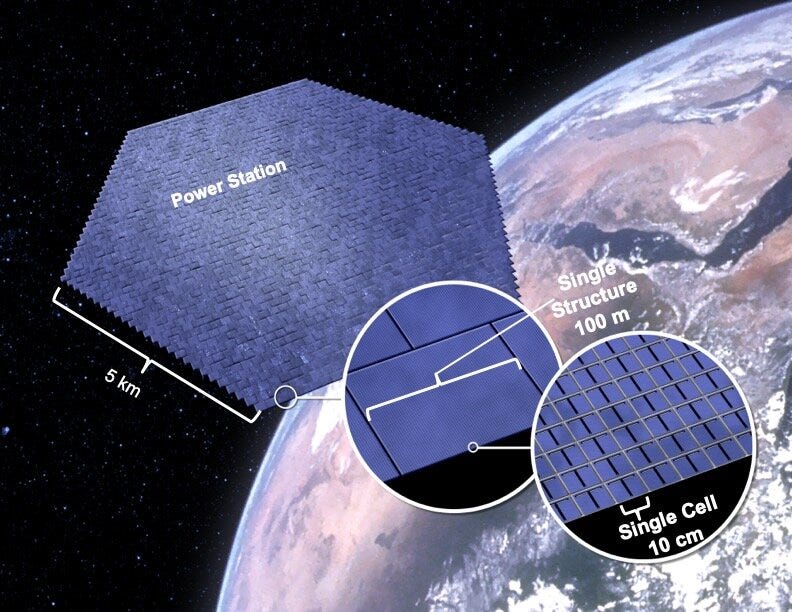Ali Hajimiri is the Bren Professor of Electrical Engineering and Medical Engineering at the California Institute of Technology. He is also co-director of the Space Solar Power Project, which is developing technology capable of generating solar power in space and beaming it back to Earth. Hajimiri and colleagues are designing solar arrays composed of hundreds of small photovoltaic tiles that would be linked together to form larger modules, and then those modules — flying together in formation like a school of fish — would form a hexagonal power station in space. These flexible arrays would be rolled up when launched and unfurl at their orbital destination.
In this inaugural episode of Faster, Please! — The Podcast, Ali tells me about how space-based solar works, what problem it solves, and how long we’ll have to wait before we see orbiting power stations in the sky. For more, check out my recent 5QQ chat with Ali. Below is a lightly edited transcript of our conversation.
Pethokoukis: Space-based solar — putting solar panels in space and beaming the energy to Earth — seems like a beautiful, elegant solution. Why is it a good idea? What problem is it solving?
Hajimiri: So the primary problem that it solves is being able to get around the days and nights, the cycles of the weather, the cloudy days, and all those things — and having dispatchable power where you need it, when you need it, and as much as you need.
An advantage over ground-based solar?
Correct. And the other benefit of it is that essentially you can have these systems in space for a long time, and you can route it the way you want. You can actually distribute the power; you can break it up into smaller pieces. You can say, “I want to send 20 percent to New York, 30 percent to LA, and 40 percent to, I don't know, Seattle.”
Wouldn’t these panels sometimes be in the darkness, on the night side of the Earth? So how would they work?
It depends on which orbit you put it in. If you put them in geosynchronous orbit (or something near geosynchronous) you are basically in the sun for most of the time, except for 20 minutes on the equinoxes. Most of the time you're not eclipsed, because you're so far away that the shadow of Earth is so small. And because of the inclination of the Earth, because it's at an angle, you would get eclipsed for 20 minutes on each one of those.
And as it’s transferring power down, it doesn't have to be directly over the collection station, right? It can be at an angle?
It doesn't. That's the beauty of it. Because it's a very large array, it redirects the energy. You can electronically steer it. It does not even need mechanical steering. So you can actually create a focal point of energy where you need, where your recovery of energy occurs. And you can move that very rapidly — on the scales of nanoseconds, extremely fast — from one place to another.
Does it require new technology to distribute that power? Or is that basically using current technology?
On the ground, we have what we call “rectennas,” which is basically rectifying antennas. These are another array of antennas that are very plain, very flat. I mean, if this were not radio, I would've had demonstrations of these things to show you how they look. But these are like thin sheets of material, like printed circuit boards that go in your computers and things of that sort, that sit on the ground. They collect the energy, they convert it to DC power, and then that's converted to AC. And then at that point, you can plug it in to connect to your network — essentially to your distribution line, the same power distribution line that you use. You can even envision putting this next to photovoltaic solar [panels] that are out there, or any other kind of power plant. It could be any kind of power plant, and you just connect to it and add and augment the power that you generate with these.
So you can basically bolt this onto the existing power system?
Yes. I mean, once you are on the ground station, once you go get past the rectenna and the conversion to AC, then that's basically compatible with all the other AC network.
Solar power is becoming cheaper, and the land area we would need to cover with solar panels to power the whole Earth is smaller than you'd think. But traditional solar relies on storage at night when the sun isn't shining. But what you're suggesting wouldn't be reliant on batteries. Is that right?
What we do allows you to send the power where you need at the time you need — and you can even break it up into different proportions. But the other thing that it does is that, since you have it 24/7, pretty much you don't need the storage, which is a big challenge.
The other thing is that there are places that don't have the power infrastructure. A good analogy to this is cell phones versus landlines. Thirty years ago, there were places in Africa that didn't have landlines. In Sub-Saharan Africa today, there are these same places that still don’t have landlines, but there they have leapfrogged to cell phones.
So this way, you can actually get to places that don't have power. You can think about the Arctic Circle — you can think about a lot of places, remote islands and things of that sort — that may not have power infrastructure. And this way you can enable it when you need to have the power over there.
This is not a new idea. It's an idea from about 80 years ago that you're attempting to turn into reality. I wonder if you could spend a minute or two talking about what you're doing.
It is an idea that I think the earliest rendition, that I know of, is in a short story by Asimov, as many ideas are. But you know, what’s different is that the technology didn't exist for doing these kinds of things in space. I mean, it sounds like a good idea, but it's also a very challenging idea in many different ways. One is that, when you put things in space, things are expensive — you pay dollars per gram. That's extremely expensive for things that you put in orbit. So one of the key parts of making this happen is to make it lightweight.
The other thing is that these array elements, making it with large arrays, were not very practical up until the point where we are in integrated circuits — the same chips that go into our computers and phones. The same technology is now what we are using to make these incredibly large arrays that are very lightweight, because these are very small and lightweight.
And then now, on top of it, we are making them flexible, because the way to deploy something that's of that magnitude is to roll it, then deploy it, and then unroll it. You can think about this like a sheet. These are like sails that you open up in space. Now, the technology to enable that integrated circuit, the packaging and all those things, did not really exist until recently. And that's why we came up with a new architecture for doing it, and that allows us to do the original renditions of this idea.
The thinking was that we have the solar panels, and we aggregate all of the power. We have this giant antenna that points to Earth and then sends it. And in that case, you would be pointing to one direction, and you couldn't move it around because it was mechanically pointed. And if you wanted to reorient it, you have to mechanically reorient that antenna and point it in a different direction. We are doing it all electronically. So we have this very thin, very flat sheet that transmits the energy. Because of the coherent addition of all these billions and billions of sources — it's like an army of ants.
So a swarm? A solar swarm?
Exactly, exactly. So we've gone from the old mindset, which was what I describe as a big elephant, as opposed to an army of ants. I mean, each one of them is capable of doing different things, but because of the swarm nature, you can actually make it very lightweight and spread out.
How old is the project that you're working on at Caltech?
We've been working on this for close to eight years now — seven or eight years actively. We've been working on the power transfer part of it — the part that I'd been working on even before this project, which is what led to this project — for like 10 or 12 years. Wireless power transfer for both terrestrial, as well as space-based applications.
And the powerless transfer is converted from sunlight into lasers? Microwaves? What?
It’s microwaves. It’s radio frequencies, essentially microwaves. Then you transmit it, and then you recover that on the ground.
Whenever I hear about any space project, I always think, “Well, was this possible before SpaceX? And is the reason we're talking about it because of that decline in launch costs?” Does your project depend on that, or is it just a fantastic enabler of it?
I would say it's one of the four or five enablers that converged to make this closer to something that can actually be done. Definitely, SpaceX is a catalyst in lowering the barrier for space enterprises — anything that you want to do, non-governmental stuff, smaller projects — SpaceX and alike. I mean, there are other places like Blue Origin, things like that.
So people are trying to do that. They are trying to level the playing field so that more entrepreneurs can get into it. Now it can be in academia, industry, or anywhere else. And that plays a role. And again, there are all these other technologies and architectural changes that also enable us. So I would say that's definitely one of the four or five catalysts that had to come together to make this happen.
I've seen a video of you describing how there are small wafers that add up into bigger panels which are arranged into this giant array. Each one would be like a power plant in space. How big would each of those be?
Yeah, that's a good way to think about it. Each one of these power plants, you can think about them on the order of a kilometer by kilometer, or about a mile by a mile. So that is like a square mile or square kilometer. Something in that range. It depends on the orbit you choose and the size of the ground station. There's a little bit of a tradeoff. You can make it larger in space and smaller on the ground, or smaller in space and larger on the ground. So there's that trade off you can play with. But yeah, it's about a square kilometer or square mile in space, each one of them.
And how much power could that theoretically generate back on Earth?
So somewhere between like several hundred megawatts to a gigawatt, depending on the angles and things like that. It's a substantial amount of power.
How would that compare to a nuclear reactor?
It would be comparable. And it can be even higher than that in some cases, depending. The other interesting thing I should say about comparing to these other kinds of generators is that, since it's a modular system — this is actually a formation flying of satellites; each one of the modules is about 20 to 60 meters, depending on different designs for different orbits; they are formation flying in close proximity to each other — and this means that if one of them fails, you can actually replace it without having to replace the whole thing. So it's very modular. You can actually have robustness because of that.
I think when they had to repair the Hubble Space Telescope, it was a pretty big deal.
Yes.
And I'd hate to think it would be as involved with fixing each of these panels. All we’d be doing is space walks.
Exactly. That's an excellent point because the way we've designed them, one of the key elements is the cost structure of these modules. It has to be economical at the end of the day, because we are using the same silicon technology that's used for all these electronics — and all the other stuff we're making at low cost. So the idea here is: For that component, we just decommission it, let it burn in the atmosphere and just put a new one in there. We don't have to replace components. It's just like a new satellite that’s put in the orbit, and the other one is just decommissioned. And the cost structure allows for that.
Would you envision this as just one arrow in the quiver? Or do you view this as something where we could get substantially all our power from space? What are sort of the potential and limitations?
I think, like any other technology, if it's successful, it'll be phased in. You can't really do it all at once. Now, as more and more of these stations are going to be put in space, then you can see how this will respond to the system. But my anticipation is that it would definitely be filling in the gaps in the baseline.
So, for example, if you look at the load line that the power generation has today on the Earth, it has changed because of the photovoltaics, quite interestingly. They had this duck — they call it the duck curve — because in the middle of the day, there's lower demand. The way it changes in the early afternoon, it goes up, peaks, and then comes back down and kind of looks like a duck.
But the interesting thing is, now photovoltaics have kind of brought up the middle of the duck. So they've brought up this middle gap that they had. And then now it's gotten to a point that, at some points, the bulk price of power is actually negative during the day. And what this does is it allows you to fill in the gaps where you need it. So for example, you could have most of your power being transmitted to New York in the afternoon, but three hours later, you can shift that power to LA, for example.
I think one thing people might say is, “We're already worried about too many Starlink satellites in orbit. These are much, much bigger! I mean, you would be able to see these from the Earth.” What do you make of that concern?
So, there are different aspects to this. Is it mostly a concern about, for example, space junk and getting crowded and all those things?
There’s the space junk concern. There are also just these sort of astronomical concerns, that it would be hard to do astronomy. And more sort of aesthetic concerns.
The aesthetic aspect, I can't talk to. I guess the beauty is in the eyes of the beholder. But the astronomy aspects: Again, there are obviously going to be windows, and there are going to be the times that this system passes overhead. But just to think about things, the area that is out there at 36,000 kilometers, which is the geosync, is actually 36 times larger than the area of the entire surface of the planet, including all of the water and all the oceans and everything. If you take that area, it's a much bigger sphere. So there's a lot more room, if anything, out there compared to other things that we make. So I'm not too concerned about that.
There are also people who think about, “Is it going to cause interference?” and all those things. And those are the kinds of things that we've learned how to deal with in radio systems. We have many different radio systems working concurrently and seamlessly, and we don't seem to have problems with that — like Wi-Fi and 5G and this and that. And you have Bluetooth, and all of these things seem to be working together. And the main reason is that we've learned how to do it in that respect.
There's also another set of concerns some people raise. “It's a health concern. Is it going to fry birds flying overhead?” And the answer to that is actually interesting, because the answer is that the energy density that anything, even in that beam spot, will get is comparable to what you get from standing out in the sun — except for the fact that it's what we call non-ionizing radiation as opposed to the sun, because it has UV and all those things that can actually change the molecules and the chemistry. So they can cause cancer (UV does), but radio frequencies don't. All they can do is generate heat. The benefit of this thing is that with that power level, you'd recover probably close to three times, three to three-and-a-half times, more than what you recover from photovoltaics. And you can have it during the day or night.
I was recently reading a big report from Citigroup about the space economy, and they went into some detail about space-based solar. That's the first time I remember reading Wall Street research about that technology. At this point, is it still so early that you're not getting much private sector interest?
First of all, I can tell you that there has been a tremendous amount of interest. I mean, especially recently, over the last couple of years, we've seen a lot more. And partly I think it’s because of the fact that the technology … I mean, 10-20 years ago, it was not really realistic because of the cost structure, the complexity of tech technologies, and all those things. But now people are starting to see the pathway. So we've had a lot of interest from various places. And it's kind of growing exponentially in a way, recently.
So I'm anticipating seeing a lot more of that investment. In fact, we've been approached by several investors in this regard, too. But it'll take time. It's not a short-term project. It's not an app that we can start today and have a first prototype working in a few weeks or months. We've been working on this for quite a while, and it has to continue on. We, in fact, are going to have a launch sometime soon, to have a first demonstration of some of the key components of the technologies that we are launching.
The Chinese seem pretty interested in this technology.
They are. And it's interesting. A lot of this thing has happened in part because of these new technologies that have been developed at Caltech and at other places that made it possible. So people are taking another look at it. There was this old kind of mindset about it, and this new mindset has renewed interest in it, because of these things. Yeah, the Chinese are interested. The United Kingdom is very interested in this. The Japanese are very interested in this. There are a lot of other efforts in other places — India is actually even interested in it. So we've actually seen a lot of interest all over the world, in this area.
Is there something you need government to do or to stop doing at this stage in the development of the technology?
A great question. One is, in terms of investment, definitely. These are the kind of things that, to get started, you need a big entity like government to put investment in it — in terms of research and development — because the barrier to entry is pretty large, regarding the amount of initial investment. Of course, the return eventually is going to be large, too.
That's important also from a regulatory perspective. It's important for government in general — about the technologies related to wireless power transfer, both terrestrial and space — I think the government needs to be more proactive in terms of allowing it to flourish and not getting in the way. With everything new that comes in, there of course needs to be a thoughtful discourse about it. But if it gets to a point of becoming too much of an impediment to innovation and progress, then that would not be a good thing.
So I think allowing these technologies to flourish — in terms of spectral allocations and other things of that sort — would be a good thing to continue to do.
Are there key, deal-breaking technological challenges that you still need to solve?
There are. I mean, it is fair to say that not all the technical challenges have been solved, but the pathway has become more clear over the last several years in terms of at least how we go about solving them. It's sometimes the unknown unknowns that get you at the end of the day. But we have more of the things that we know that we need to figure out. And I think we have a clear pathway.
But in general, nobody has built a coherent structure of this magnitude anywhere — not even on Earth, let alone in space. So for example, that analogy that I used earlier: If you have an army of ants, you want the ants, that are like a mile apart, to be synchronized within a few picoseconds (and a picosecond is one-trillionth of a second).
So the timing accuracy of that — that kind of thing … We have solutions; we are working on things. It's a combination of various advanced technologies that allows us to get this kind of timing synchronization. But those are the kind of challenges that we're trying to overcome and solve when you go to this scale. And it is something that has emerged because we've solved the other problems. Now we are at the point to say, “Okay, well, now we are scaling it up. How do we do these things?” And we need to solve these problems.
How long until space-based solar arrives? Are we talking the 2030s? The 2040s?
I'm more on the optimistic side, I guess. I think probably by the end of the 2020s, you will have some demonstration, some power transfer demo. We are going to have to show it soon. We are going to have some technology demonstrations.
But if you want to have a substantial amount of power transferred, probably before the end of this decade. It would probably not provide a whole lot of our power at that point. That takes another decade or two to get to that point — if this pathway turns out to be the right pathway to go down.
Ali, thanks for coming on the podcast.
No problem. It's my pleasure.













